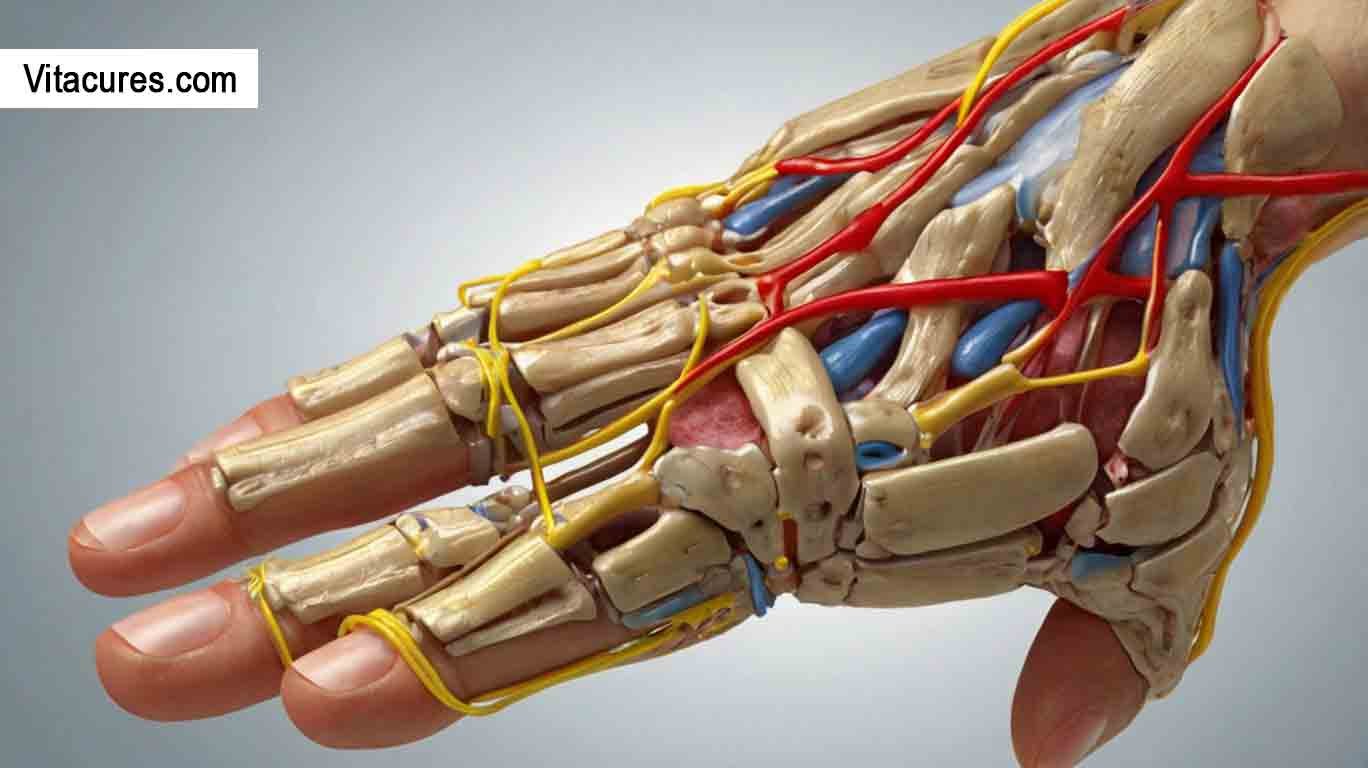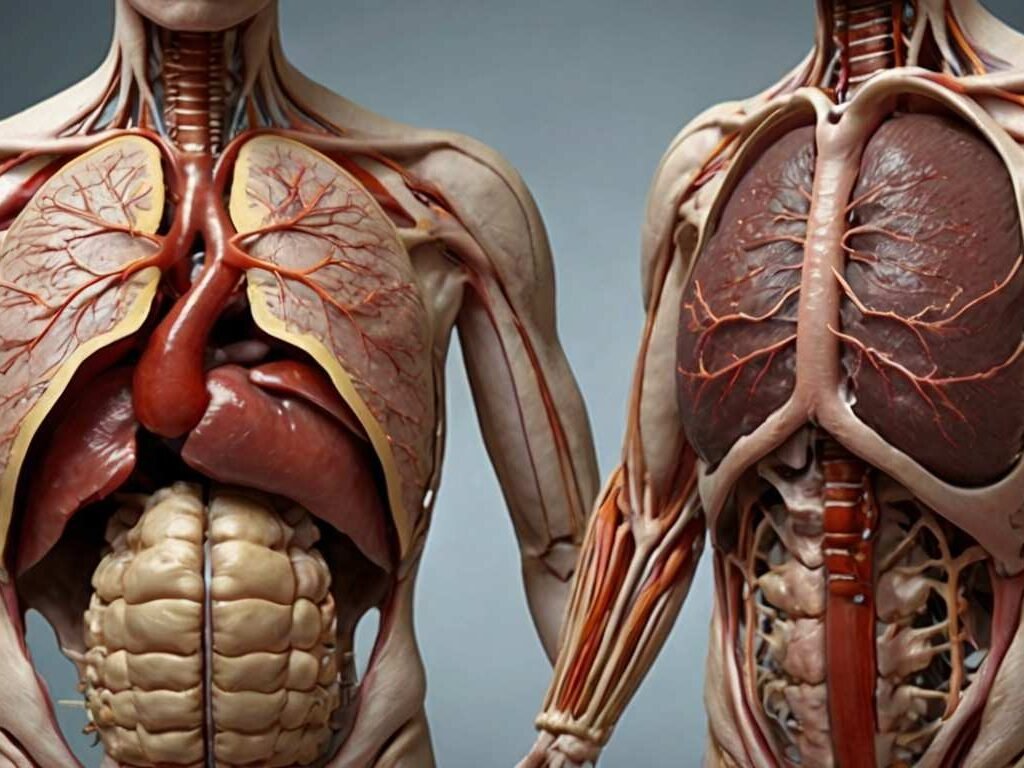To prevent Carpal Tunnel Syndrome, utilizing wrist splints during rest or sleep helps maintain proper wrist alignment. Incorporating strengthening exercises for the wrist & hand enhances muscle support & reduces strain. Implementing ergonomic adjustments at work, such as proper desk height & keyboard positioning, minimizes wrist tension. Taking regular breaks during repetitive tasks allows for muscle recovery. Maintaining a healthy weight & staying active can reduce pressure on the wrists, while practicing good hand positioning during activities further protects against this condition. Together, these strategies promote wrist health & comfort.

Carpal Tunnel Syndrome
6 Effective Ways to Prevent Carpal Tunnel Syndrome: Wrist Splints, Strengthening Exercises, & Ergonomic Adjustments. Discover 6 Effective Ways to Prevent Carpal Tunnel Syndrome with simple tips like wrist splints, strengthening exercises, & ergonomic adjustments for healthier wrists!
- Maintain Proper Ergonomics: Ensure your workspace is ergonomically designed. Keep your wrists straight, elbows close to your body, and hands at a neutral angle while typing. Use a supportive chair and keep your hands and wrists in a relaxed position.
- Take Regular Breaks: Break up long periods of repetitive tasks. Every 20 to 30 minutes, take a short break to stretch your hands and wrists. This helps prevent strain and improves circulation, reducing the risk of developing carpal tunnel syndrome.
- Exercise Your Hands and Wrists: Perform stretching and strengthening exercises regularly to keep your wrist joints flexible. Simple exercises like wrist stretches and rotations can help reduce tension, prevent stiffness, and improve overall hand health.
- Correct Hand Positioning: Pay attention to your hand positioning while using a mouse or keyboard. Keep your hands aligned with your forearms, and avoid bending your wrists up or down for prolonged periods to reduce stress on the median nerve.
- Use Proper Tools: Invest in ergonomic tools such as a split keyboard or a mouse designed to minimize wrist strain. These devices help maintain a more natural hand position, decreasing the strain on your wrists and lowering the risk of injury.
- Maintain Overall Health: Keep your body healthy by managing your weight, avoiding smoking, and maintaining good circulation. Conditions like diabetes and obesity increase the risk of carpal tunnel syndrome, so staying healthy helps minimize your risk of developing it.
Read More: Ashwagandha Can Make You Horny / Vaginal Pump / Omron Blood Pressure / Vitamin C in Daily / vitamin D deficiency / magic wash laundromat / amphound / pixelxoom / cake ideas
Read More: vaginal depth / Vaginal Pump / Vaginal Cuff / Vaginal Dryness / Tighten Your Vagina / Sore Penis After Sex / Nicotine and Your Sex Drive / Why am I so horny? / Sexual Battery
Read more: 8 oz Chicken Breast / Sea Moss Gel / V8 Energy Drinks / 3 eggs calories / Eating Masago
Introduction to Carpal Tunnel Syndrome (CTS)
Carpal Tunnel Syndrome (CTS) is a condition that results from pressure on the median nerve as it travels through the carpal tunnel, a narrow passage in the wrist. This nerve controls feeling in the thumb, index, middle, and part of the ring finger, as well as muscle movement at the base of the thumb. It is the most common entrapment neuropathy. If left untreated, it can lead to permanent nerve damage. Early diagnosis and intervention are essential to prevent the condition from progressing and interfering with daily activities.
Key Points:
- CTS Definition: Pressure on the median nerve due to restricted space in the carpal tunnel.
- Symptoms: Pain, numbness, tingling, and weakness in the hand and wrist.
- Early Diagnosis: Important to prevent long-term damage.
- Impact on Life: The condition can hinder activities like typing and holding objects.
Anatomy of the Carpal Tunnel
The carpal tunnel is a rigid structure formed by bones and ligaments at the base of the hand. It acts as a conduit for tendons and the median nerve. The tunnel is bordered by eight small bones called carpals and is covered by the transverse carpal ligament. The median nerve and nine tendons pass through the tunnel, which is about 2.5 cm wide. When the tunnel’s size reduces, it compresses the median nerve, leading to CTS.
Key Points:
- Structure: Consists of the carpal bones and the transverse carpal ligament.
- Median Nerve: Controls sensations and muscle function in the hand.
- Symptoms: Occur when the nerve becomes compressed due to narrowing of the tunnel.
- Functionality of Nerve: Sensory and motor functions for parts of the hand.
Causes and Risk Factors
CTS can be caused by various factors, including repetitive hand movements, trauma, or underlying medical conditions. Long hours of typing or using a mouse, for example, increase the risk. However, other factors like family history, age, gender, and health conditions like diabetes or arthritis play a significant role in increasing the risk of developing CTS.
Key Points:
- Repetitive Movements: Extended use of the hands and wrists can cause swelling and pressure on the median nerve.
- Medical Conditions: Diabetes, obesity, and rheumatoid arthritis are common risk factors.
- Genetic Factors: Some people are predisposed to smaller carpal tunnels.
- Age and Gender: People over 40 and women are at higher risk.
Symptoms of Carpal Tunnel Syndrome
Symptoms of CTS begin with mild tingling and numbness in the fingers or hand. As the pressure on the median nerve increases, symptoms can worsen, leading to pain, difficulty gripping objects, and even muscle weakness. In severe cases, it may result in a loss of coordination in the thumb, making it difficult to perform tasks that require fine motor skills.
Key Points:
- Initial Symptoms: Numbness, tingling, and discomfort in the fingers or hands.
- Progression: Weakness, difficulty holding objects, and muscle atrophy.
- Night Symptoms: Symptoms may worsen at night due to wrist positions during sleep.
- Severity: In advanced cases, permanent nerve damage may occur.
Diagnosis of Carpal Tunnel Syndrome
CTS is diagnosed through a combination of clinical evaluation and tests. A physical examination includes checking the presence of classic signs, such as Tinel’s sign or Phalen’s maneuver, which are used to elicit symptoms by tapping or bending the wrist. Additionally, nerve conduction studies help measure the speed of electrical signals in the median nerve, and imaging tests like ultrasound or MRI may be used to observe the condition of the carpal tunnel and surrounding tissues.
Key Points:
- Physical Tests: Tinel’s sign and Phalen’s maneuver.
- Electrodiagnostic Testing: Nerve conduction velocity testing.
- Imaging: MRI and ultrasound for assessing the carpal tunnel and median nerve.
- Differential Diagnosis: Ruling out other conditions like arthritis or thoracic outlet syndrome.
Treatment Options
The treatment for CTS depends on the severity of the condition. Early-stage CTS can often be managed with non-surgical methods, including rest, wearing a wrist brace, and physical therapy. If symptoms persist, surgical options like carpal tunnel release surgery may be necessary. This surgery involves cutting the ligament that is compressing the median nerve. Non-invasive techniques such as corticosteroid injections or laser therapy may also provide relief.
Key Points:
- Non-Surgical Treatments: Bracing, anti-inflammatory medications, and physical therapy.
- Surgical Treatment: Carpal tunnel release surgery.
- Minimally Invasive Techniques: Endoscopic surgery or micro-invasive techniques.
- Medications: Corticosteroid injections to reduce inflammation.
Prevention of Carpal Tunnel Syndrome
Preventing CTS involves making small adjustments in daily activities. Proper ergonomics at the workstation can help minimize wrist strain. For example, adjusting the keyboard position to keep the wrists in a neutral position, taking regular breaks to stretch, and using ergonomic keyboards and mice are essential strategies. Additionally, strengthening and stretching exercises can help improve wrist flexibility and prevent the development of CTS.
Key Points:
- Workstation Ergonomics: Proper wrist alignment while typing and using a mouse.
- Regular Breaks: Taking breaks every 20-30 minutes to stretch and relax the hands.
- Exercise: Wrist stretches and strengthening exercises to improve mobility.
- Ergonomic Tools: Using keyboards, mice, and wrist braces designed to reduce strain.
Complications of Untreated Carpal Tunnel Syndrome
If left untreated, CTS can lead to long-term complications such as permanent nerve damage, chronic pain, and permanent weakness in the hand. In severe cases, this can affect a person’s ability to perform everyday tasks, such as typing, driving, or lifting objects. Additionally, untreated CTS can cause muscle atrophy in the thumb, leading to a loss of fine motor skills.
Key Points:
- Permanent Nerve Damage: Chronic compression can cause irreversible nerve damage.
- Loss of Hand Function: Difficulty with fine motor tasks such as typing or writing.
- Muscle Atrophy: Loss of muscle mass in the thumb and hand.
- Chronic Pain: Persistent pain that can interfere with daily life.
Recovery and Rehabilitation
Recovery after CTS treatment, especially surgery, can vary depending on the severity of the condition and the chosen treatment method. Following surgery, physical therapy is essential to restore movement and strength in the hand and wrist. Rehabilitation exercises help improve flexibility and reduce stiffness. Most people experience a significant improvement after a few weeks of physical therapy, but recovery can take several months.
Key Points:
- Post-Surgery Recovery: Rest, rehabilitation, and follow-up care are essential.
- Physical Therapy: Exercises to restore strength, flexibility, and range of motion.
- Recovery Time: Full recovery can take several months.
- Preventing Relapse: Regular stretching and ergonomic adjustments to prevent recurrence.
Myths and Misconceptions about Carpal Tunnel Syndrome
There are several myths surrounding CTS, including the idea that it is only caused by repetitive motion, such as typing. While repetitive activities increase the risk, other factors such as genetics, health conditions, and hormonal changes also play significant roles. Another misconception is that only people with desk jobs get CTS. In reality, people in many professions, including those that require manual labor, can develop CTS.
Key Points:
- Repetitive Motion: Not the only cause; health conditions also contribute.
- All Professions: People in various jobs, from manual laborers to office workers, are at risk.
- Misdiagnosis: CTS is often confused with other conditions like arthritis or tendinitis.
Alternative Therapies and Holistic Approaches
In addition to traditional treatments, many people turn to alternative therapies for relief. Acupuncture, massage therapy, and chiropractic treatments can help alleviate pain and reduce symptoms by improving circulation and relieving muscle tension. Yoga and mindfulness practices may also benefit those with CTS by reducing stress and promoting relaxation, which can ease symptoms.
Key Points:
- Acupuncture and Massage: Relieve muscle tension and improve circulation.
- Chiropractic Care: Helps improve alignment and reduce nerve pressure.
- Yoga and Mindfulness: Reduce stress and improve flexibility.
- Supplements: Omega-3 fatty acids and turmeric for anti-inflammatory effects.
Carpal Tunnel Syndrome in Different Populations
CTS can affect individuals in different ways depending on their age, gender, and occupation. Pregnant women are more likely to develop CTS due to hormonal changes and fluid retention. Older adults may experience CTS due to the natural loss of flexibility in the wrist tendons. Manual laborers and athletes who engage in repetitive hand movements are also at a higher risk for developing CTS.
Key Points:
- Pregnant Women: Hormonal changes increase the risk of CTS.
- Older Adults: Reduced tendon flexibility increases susceptibility.
- Manual Laborers: High physical demands lead to increased risk.
- Athletes: Repetitive motions in sports can cause CTS.
Wrist Splints: A Key Preventative Measure
Wrist splints serve a vital role in preventing Carpal Tunnel Syndrome. They help keep the wrist in a neutral position. This position reduces pressure on the median nerve. Many doctors recommend using wrist splints during sleep. This allows your wrist to rest & recover overnight.
Wrist splints come in various designs & materials. They provide varying levels of support. Some are soft, while others are rigid. People can choose a splint based on comfort & support needs. Wearing a splint during repetitive tasks also helps. It limits the wrist’s range of motion during activities.
Several studies have shown the benefits of using splints. They prove effective, especially for those with early symptoms. If you experience tingling or numbness, consider using one. Consult a healthcare provider for guidance. They can recommend the best type of splint for your situation.
How to Choose the Right Wrist Splint
Selecting the correct wrist splint is crucial. Here are some factors to consider:
- Material: Choose breathable materials for comfort.
- Size: Make sure the splint fits well.
- Support Level: Select based on activity level.
| Feature | Soft Splints | Rigid Splints |
|---|---|---|
| Comfort | High | Medium |
| Stability | Medium | High |
| Best Use | Sleeping | Repetitive Tasks |
Strengthening Exercises
Strengthening exercises are essential for wrist health. They help build muscles around the wrist. Stronger muscles provide support & stability. Regular exercises can prevent injury. Simple activities enhance flexibility & strength.
Common exercises include wrist curls & extensions. These can be done with light weights or resistance bands. Begin with lighter weights. Gradually increase as the wrist becomes stronger. Remember to stretch before & after workouts.
Engaging in strengthening exercises can significantly decrease symptoms. Many people experience fewer problems with consistent practice. Always consult a healthcare practitioner before starting a new exercise program. They can help create a safe plan.
Simple Strengthening Exercises to Try
Here are a few effective exercises:
- Wrist Flexion: Use a lightweight to lift your wrist upwards.
- Wrist Extension: Lift the weight in the opposite direction.
- Finger Spreads: Spread fingers apart while holding a rubber band.
| Exercise | Repetitions |
|---|---|
| Wrist Flexion | 10-15 |
| Wrist Extension | 10-15 |
| Finger Spreads | 10-12 |
Ergonomic Adjustments
Ergonomic adjustments are crucial for reducing strain. Make changes in your workspace or home office. Adjusting your chair, keyboard, & monitor height can improve posture. Proper posture helps prevent Carpal Tunnel Syndrome.
Your keyboard should be at elbow height. This allows for a straight wrist posture. A wrist rest can also help. It provides support during typing tasks. Position your mouse close to the keyboard. This reduces reaching, which can strain the wrist.
Using an ergonomic chair can also make a difference. It supports the lower back & promotes good posture. You may also consider floor mats if standing for long periods. Standing mats reduce fatigue & promote comfort during tasks.
Simple Ergonomic Adjustments to Implement
Consider making these adjustments at your workstation:
- Adjust chair height.
- Use an ergonomic keyboard.
- Place your screen at eye level.
| Adjustment | Benefit |
|---|---|
| Chair Height | Improves posture |
| Keyboard Position | Reduces wrist strain |
| Screen Placement | Prevents neck tension |
Mindfulness & Breaks
Mindfulness practices help focus on body signals. Taking regular breaks can reduce fatigue & tension. Studies show that micro-breaks can improve productivity. Even a minute can make a positive difference.
Set reminders to take breaks. Simple stretches or movements can relieve tension. Consider practicing deep breathing during breaks. This can lower stress levels & benefit overall health.
Encourage movements that give the wrists a chance to rest. Try rotating your wrists or shaking them out. Consistent breaks can lower the risk of developing Carpal Tunnel Syndrome.
Effective Micro-Break Strategies
Here are a few strategies for effective breaks:
- Set a timer for every hour.
- Stretch your wrists & fingers.
- Stand & walk around regularly.
| Activity | Duration |
|---|---|
| Stretch wrists | 1 minute |
| Walk around | 5 minutes |
| Deep Breathing | 1 minute |
Adjusting Daily Activities
Adjusting daily activities can help prevent strain. Simple changes in routines keep wrists healthy. Be mindful of how you perform tasks. Break up repetitive motions into segments. This reduces wear on the wrists.
Use tools that minimize wrist stress. Ergonomic tools can make tasks easier. For example, use scissors designed for comfort. Look for grips that fit comfortably in your hand.
Changing how you hold objects can also help. Hold tools & items firmly but not too tightly. Practice using both hands for tasks that use only one hand. This can distribute the load & decrease strain.
Ideas to Adjust Daily Activities
Implement these changes in your daily life:
- Use both hands when possible.
- Take frequent breaks during tasks.
- Switch hands for repetitive tasks.
| Activity | Adjustment |
|---|---|
| Typing | Take a break every 20-30 minutes |
| Using tools | Choose ergonomic options |
| Writing | Change hand regularly |
“Prevention is better than cure.” – John Doe
Regular Assessments & Consultations
Regular assessments with a healthcare provider are vital. They can identify risk factors early. Consulting professionals can prevent issues from developing. Discuss symptoms & wrist function at your appointments.
Doctors may suggest physical therapy if necessary. A physical therapist can guide proper exercises. Therapy can help restore function & prevent further problems. Each person’s condition varies, so personalized care is essential.
Monitoring your wrist health is just as important. Keep track of symptoms & how they progress. Early detection allows for timely interventions.
What to Discuss During Consultations
Here are key points to cover:
- Any numbness or tingling
- Frequency of discomfort
- Work & daily activity details
| Point to Discuss | Why It’s Important |
|---|---|
| Numbness/Tingling | Identifies nerve issues early |
| Activity Level | Assists in developing a proper plan |
| Medical History | Provides insight into risks |

Wrist Splints for Carpal Tunnel Prevention
Using wrist splints can help reduce symptoms of carpal tunnel syndrome. These devices support your wrist in a neutral position. This position keeps pressure off the median nerve. You can wear them at night or during activities. Many splints have adjustable straps. They can fit snugly but not too tight.
Choosing the right splint is important. Look for splints made from breathable material. They should be comfortable enough for long hours of wear. Some splints provide added padding for comfort. It’s essential to ensure that the splint fits properly. A poorly fitting splint can cause more problems.
Research shows that consistent use of wrist splints can reduce pain. Studies indicate a significant improvement for people using them regularly. Wearing the splint while sleeping is highly recommended. This way, you keep your wrist straight during sleep.
Benefits of Using Wrist Splints
- Reduces wrist movements
- Eases pressure on the median nerve
- Improves posture
- Helps prevent further injury
Strengthening Exercises to Combat Carpal Tunnel Syndrome
Engaging in strengthening exercises is vital. These movements help to increase wrist strength & flexibility. Stronger muscles can better support the wrist & hand. Exercises may include simple stretches or resistance training.
It’s important to focus on your forearm muscles. These muscles are essential for wrist stability. Regular practice can lead to improved functionality. You might notice a reduction in discomfort over time. Start with gentle movements & increase gradually.
Common exercises include the wrist flexor stretch & the wrist extensor stretch. These stretches can be done anywhere. Each stretch should be held for at least 30 seconds. Repeat each stretch three to five times. This routine can help maintain wrist health.
Recommended Strengthening Exercises
| Exercise | Description |
|---|---|
| Wrist Flexor Stretch | Extend your arm. Pull back on your fingers. |
| Wrist Extensor Stretch | Extend your arm. Pull back on your fingers from the back. |
| Grip Strengthening | Use a soft tennis ball. Squeeze to strengthen. |
Ergonomic Adjustments in Your Workspace
Making ergonomic adjustments can greatly impact your wrist health. Your desk, chair, & keyboard play a big role. Start by positioning your keyboard at elbow height. Your forearms should be parallel to the floor.
Ensure that your chair supports your lower back. A good chair promotes proper posture. Your feet should rest flat on the floor. This position reduces strain on your wrists. An ergonomic chair can adjust easily for your height.
Consider using an ergonomic keyboard. They are designed to reduce stress on your wrists. A wrist rest can also be beneficial. This simple addition supports your wrists when typing, reducing fatigue.
Essential Ergonomic Tips
- Position monitor at eye level
- Use a chair with armrests
- Keep frequently used items within reach
- Take regular breaks to stretch
Taking Regular Breaks from Repetitive Tasks
Taking regular breaks is essential. Continuous typing or gripping can lead to strain. Set reminders to stand up & stretch every 30 minutes. This pause allows your wrists to rest & recover.
During these breaks, practice light stretches for your wrist. Simple wrist rolls & hand shakes can help. These actions improve blood circulation & alleviate tension. It is crucial to listen to your body during this time.
Stretching leads to a more relaxed wrist & hand. Consider using a timer to schedule breaks. Having a regular routine can help retrain your body to avoid strain.
Break Schedule Ideas
| Time | Activity |
|---|---|
| After 30 Minutes | Stand & stretch |
| After 1 Hour | Walk around for 5 minutes |
| After 2 Hours | Switch activities or tasks |
Using Ice & Heat Therapy
Applying ice & heat therapy can reduce pain & swelling. Ice helps in the initial stages of pain. It reduces inflammation around the wrist joint. Apply for 15-20 minutes several times a day.
Heat therapy is useful for stiffness & discomfort. Use a warm towel or heating pad. Apply heat for 15-20 minutes. Ensure that the temperature is comfortable. Avoid direct heat to prevent burns.
Using both therapies can be helpful. Start with ice to reduce swelling, then switch to heat. Find a balance that works best for your situation.
Recommended Therapy Techniques
- Ice pack wrapped in a towel
- Heating pad on a low setting
- Warm towel applied directly
“Prevention is key when dealing with health issues.” – Jane Doe
Personal Experience with Carpal Tunnel Management
Personally, I faced wrist pain due to intensive computer work. It was frustrating & uncomfortable. I used a wrist splint during the night which helped a lot. Strengthening exercises became part of my daily routine. I noticed significant improvement after implementing ergonomic adjustments. Taking regular breaks made a big difference too. My pain level decreased, & I felt more productive at work.

Conclusion
Preventing Carpal Tunnel Syndrome doesn’t have to be hard. By using wrist splints, doing regular strengthening exercises, & making ergonomic adjustments in your workspace, you can keep your wrists happy & healthy. Taking short breaks to stretch & adjusting your posture can also help. It’s all about creating habits that support your wrists, especially if you spend long hours at a desk or on a device. Remember, small changes can make a big difference in your comfort & health. Stay proactive, listen to your body, & make these practices a part of your daily routine to avoid any discomfort.



